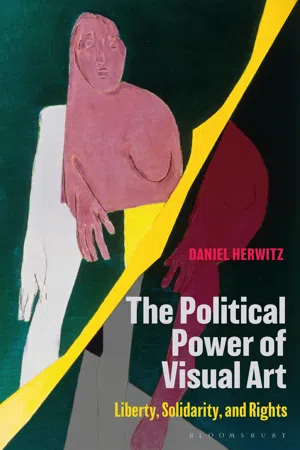
The Political Power of Visual Art
Liberty, Solidarity, and Rights
Daniel Herwitz
- 216 pages
- English
- PDF
- Available on iOS & Android
The Political Power of Visual Art
Liberty, Solidarity, and Rights
Daniel Herwitz
About This Book
Visual art has a ubiquitous political cast today. But which politics? Daniel Herwitz seeks clarity on the various things meant by politics, and how we can evaluate their presumptions or aspirations in contemporary art. Drawing on the work of William Kentridge, drenched in violence, race, and power, and the artworld immolations of Banksy, Herwitz's examples range from the NEA 4 and the question of offense-as-dissent, to the community driven work of George Gittoes, the identity politics of contemporary American art and (for contrast with the power of visual media) literature written in dialogue with truth commissions. He is interested in understanding art practices today in the light of two opposing inheritances: the avant-gardes and their politicization of the experimental art object, and 18th-century aesthetics, preaching the autonomy of the art object, which he interprets as the cultural compliment to modern liberalism. His historically-informed approach reveals how crucial this pair of legacies is to reading the tensions in voice and character of art today. Driven by questions about the capacity of the visual medium to speak politically or acquire political agency, this book is for anyone working in aesthetics or the art world concerned with the fate of cultural politics in a world spinning out of control, yet within reach of emancipation.
Frequently asked questions
Information
Table of contents
- Cover
- Half Title
- Series
- Title Page
- Copyright
- Contents
- Figures
- Acknowledgments
- 1 Introduction
- 2 The Politics of Visibility: Lurie and Rancière
- 3 Art and the Mining of Diamonds: Kentridge, Modisakeng, and What Is Meant by Politics
- 4 The Politics of the Witness: Georges Gittoes
- 5 Virulent Nationalism and the Politics of Offense: The NEA 4
- 6 Literature and the Politics of the Truth Commission: Dorfman and Coetzee
- 7 Identity Politics in a Consumerist World
- 8 Art Market Politics: Manet to Banksy
- 9 Autonomy as Negotiation: Mozart Reconsidered
- 10 Film, the Individual, and the Collective
- Notes
- Bibliography
- Index